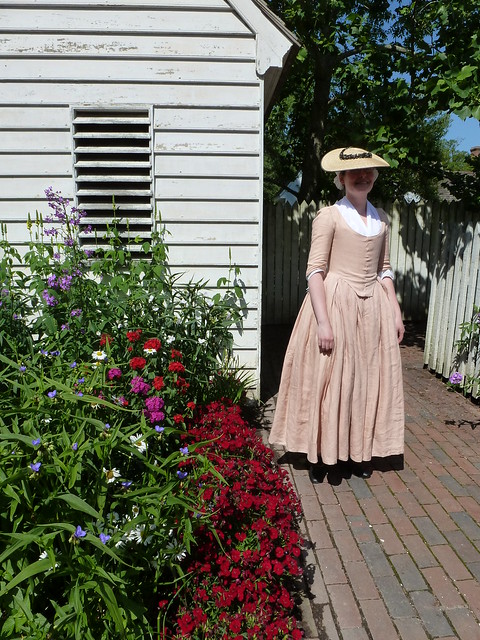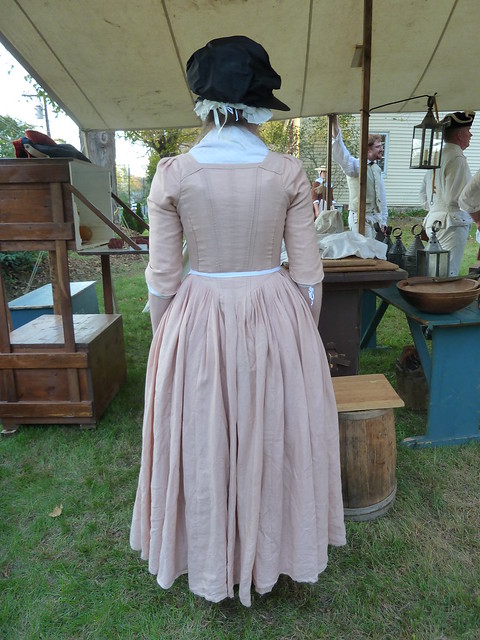A Peachy Linen English Gown, 1770-1780

Colonial Williamsburg, May 2012.
Yet another long-delayed project post from a gown finished last summer...
The pattern: Draped by me.
Construction details: The cut of this gown is almost identical to that of the blue and white striped linen gown, so the construction process is exactly the same as well. Because of that, I won't bore you with repeating the details (including identical interior shots!) again, but be sure to check out that earlier post if you're interested in reading more.
The fitted "English" back of the gown, with the en fourreau pleats
that extend from the shoulders to the waist.
South Britain, October 2011.
Colonial Williamsburg, May 2012
The fabic: A super-lucky Denver Fabrics find from a couple of years ago. It's a lovely, summery light-weight linen in a peachy-pinkish color. Very nice to work with, though both its blessing and its curse is that, like all good linen, it holds a crease quite well!
Finishing the look: I finished the gown last July and wore it for the first time during our shoe workshop. With our breathtakingly busy schedule that week, though, picture-taking time was scarce and I'm not surprised, looking back in the picture file now, to find that we never got a picture of it then. The second time I wore it was for our "1776: South Britain Comes Alive" event in October. For that outing, I paired the gown with my newly completed black silk bonnet and a white self-checked linen apron and matching kerchief. As I explained in the bonnet post, this overall look was inspired by the Stubbs painting that served as one of my bonnet inspiration sources:
The "Stubbs"-inspired look.
South Britain, October 2011.
Detail from George Stubbs, The Haymakers (1785).
Image linked from the Tate Gallery.
On our recent visit to Colonial Williamsburg last month, I brought out the gown again, this time adding a simply-trimmed straw hat with forrest green silk taffeta ribbons and a self-striped cotton lawn kerchief to help dress it up just a teensy bit.

Colonial Williamsburg, May 2012.





6 comments:
I remember this gown from our workshop. I will have to check but I might have a picture of you wearing it. If I do I will send it to you. It was a very busy schedule! And while I took lots of pictures I never thought to ask anyone to take pictures of me. Would love to have had a picture of me working when I was sitting on the shoemakers bench. Ah well.
Speaking of shoe making... Will you and your sister be available Aug 7-8? Mr Walker will be in the area and I'm trying to organize a place for us to work on our shoes.
-Emily
Emily, I just tried to send you an email and it bounced back. Have you changed your email address?
I just got the photos you emailed. Thank you! Sometimes my work email kicks things back if there are large files attached. Sorry about that.
-Emily
Lovely, lovely! I'd be afraid to wear anything to a shoe workshop that would get stained!
Laurie
Laurie, that thought did cross my mind because shoemaking turned out to be much more messy than I expected it would be! But I went well armed with my three camp aprons and my gowns escaped without harm! :-) It was so much fun learning the trade in 18th century dress, though - even if the gowns had met with mishap, I don't think I would have minded because it would have been well worth it just to have that "full immersion" experience. :-)
I know this is an older post, but I'm hoping to sew an English gown like your many wonderful examples. I'm not quite to draping my own, but have several patterns (Fig Leaf, JP Ryan, Mill Farm). Which is the closest to this style? I love the en fourreau and the polonaise.
Post a Comment